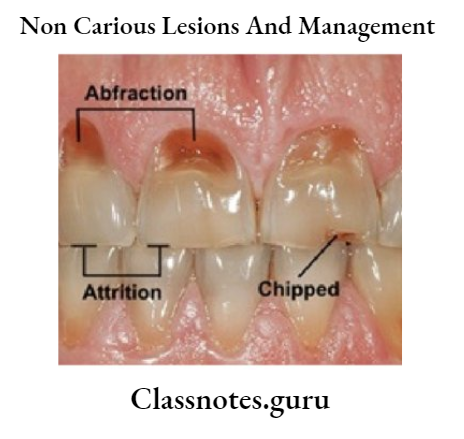Non-Carious Lesion Long Essays
Question 1. Define class 5 cavity. Enumerate various materials used for restoring it. Add a note on abstraction.
Answer:
Class 5 Cavity: Caries on the gingival third of facial and lingual or palatal surfaces of all teeth
Class 5 Cavity Materials Used For Its Restoration:
- GIC
- Composite
- Silver Amalgam
Class 5 Cavity Abfraction:
- Wedge-type defects usually occur in cervical areas of the tooth due to excessive occlusal stresses or parafunctional habits

Class 5 Cavity Etiology: Occlusal loading on the tooth
Class 5 Cavity Features:
- Single tooth involvement
- Sharply defined wedge-shaped defect
- Involvement of facial surfaces
- Initially, minor irregular crack on the enamel
- Later, the notch extending into dentin
Read And Learn More: Operative Dentistry Short And Long Essay Question And Answers
Management Of Abrasion, Erosion, And Abfraction:
1. Preventive:
- Correct occlusal disharmony
- Use of appliances to prevent bruxism
- Correct ill-fitting metal clasps/dentures
2. Restorative:
- Materials used
- Composite resins
- Glass Ionomer cement
- Silver amalgam
3. Endodontic Treatment
4. Periodontic Treatment
Non-Carious Lesion Short Essays
Question 1. Non-carious lesions and their management.
Answer:
Non-Carious Lesions And Their Management:
- Erosion: Erosion is the loss of tooth substance caused by a chemical process that does not involve known bacterial action.
- Abrasion: Abrasion is the loss of tooth substance through some abnormal mechanical process other than tooth contact
- Abfraction: Wedge-type defects usually occur in cervical areas of the tooth due to excessive occlusal stresses or parafunctional habits
Etiology: Occlusal loading on the tooth
Question 2. Erosion.
Answer:
Erosion:
Erosion Definition – Erosion is the loss of tooth substance caused by a chemical process that does not involve known bacterial action.
Erosion Causes:
1. Intrinsic:
- Eating disorder
- Gastrointestinal disorder
- Chronic alcoholism
- Pregnancy morning sickness
2. Extrinsic:
- Dietary origin
- Occupational
- Drug-induced – Aspirin
Erosion Features:
- Broad saucer-shaped depression
- Surface – smooth, hard, and polished
- Sensitive tooth
- Site – Gingival third of the labial surface of anterior
Question 3. Abrasion.
Answer:
Abrasion Definition:
- Abrasion is the loss of tooth substance through some abnormal mechanical process other than tooth contact
Abrasion Causes:
- Faulty oral hygiene practice
- Abnormal oral habits
Abrasion Features:
- Saucer shaped indentation
- Smooth, shiny surface
- Teeth affected – canines and premolars
- Unilateral
- Sharply defined margins and internal angles
Non-Carious Lesion Viva Voce
- Abrasion is seen as a sharp 5-shaped notch in a gingival portion of the facial aspect of the tooth
- Abfraction seen as sharp notch or wedge-shaped lesions
